Adding Fan Control to the 9800 Pro with XT PCB |
|
|
Author: W1zzard
Date: 2004-10-14 17:58:00
|
|
Introduction
For many users video card fan noise has been a necessary evil when using high-end video cards. On ATI's X800 and 9800XT the fan's speed is decreased when the temperature is low, to keep noise at a minimum. This is done by using an additional hardware monitoring chip on the board (LM63 page at National Semiconductor).With ATITool it is even possible to set your own values for temperature and speed.
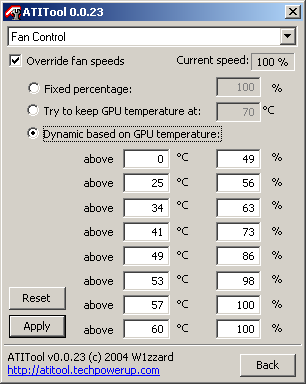
For an unknown reason this much wanted feature is not enabled on the 9800 Pro with XT PCB. In this guide we will show you how to enable it with a little bit of soldering and one part which is less than $1.
Requirements
First of all, your card MUST have the 9800 XT PCB with an LM63 monitoring chip - see this article: Does my ATI card support temperature monitoring? (picture 3).Another prerequisite is that your card is flashed with a real XT bios (Bios Collection here). This is because only the XT bios has support for controlling the fan output of the LM63.
Make sure you flash to an XT and verify that it is working at this point - BEFORE soldering. As soon as the resistor is removed, the fan will not spin if the bios does not support fan control. If that happens to you, read "Problems?" further down.
The Mod

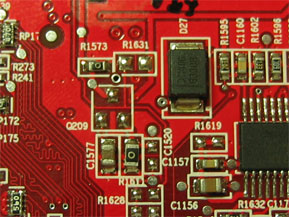
This is the area we will be working in. Of particular interest are R1573 and Q209.
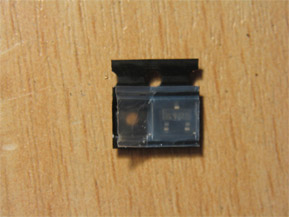
The needed transistor is a MMBT2222A in SOT-23 packaging which is one of the most common transistors and should be fairly easy to get. You can also use the 2N2222A in TO-18 metal package if you have problems finding the MMBT2222A, it'll work fine but won't be as convenient to solder in.
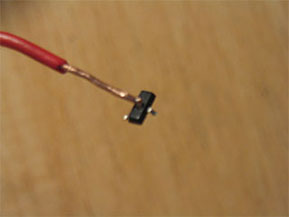
A little trick for easier handling of the transistor: Grab a toothpick/pin/solid wire and glue one end to the middle of the transistor package. Makes it much easier to place the transistor on the PCB and keep it there while soldering.
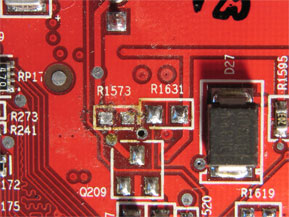
Unsolder resistor R1573.
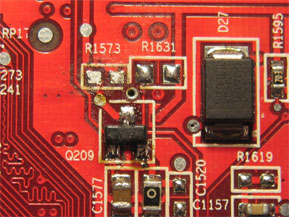
Solder your 2N2222A into spot Q209. Finished.
Some cards have both R1573 and Q209 installed, on these cards all you have to do is remove R1573.
The following pictures from nanobug show that his card has both R1573 and Q209 in place, after removing R1573 fan control worked.


Problems?
First of all don't panic if the fan is not moving. As long as you stay away from 3D applications, you have at least several minutes (if not more) before the card overheats. I tried about five minutes and the card was really really hot but still works fine.- Shut down the computer
- Solder a wire to each pad of R1573. When those wires are tied together, the fan will always be running at 100%, no matter if the bios supports fan control.
- Tie those wires together and try another bios.
- Untie them after rebooting with the new bios and see if the fan works. Boot fully into Windows and check the fan again. It is possible for the fan to stop moving when loading Windows.
- If the fan does not move, try another bios until you find one. Our large Bios Collection can be found here.
Un-Doing the Mod
If you want the "old" always-100% fan back, just connect the two solder points of R1573, Q209 can stay in place. It is not needed to solder a 0 Ohm resistor into R1573, just a wire or solder blob will do, both has 0 Ohms resistance and is completely equal to the resistor.Disclaimer: All modifications are done at your own risk. Soldering on your video card will void your warranty.
Mar 19th, 2025 15:52 EDT
change timezone
Latest GPU Drivers
New Forum Posts
- HalfLife2 RTX Demo Is out! (149)
- Anime Nation (13017)
- CableMod Classic ModMesh RT Series Cable Kit ASUS ROG/Seasonic - Black/Red (2)
- *Severe micro stutters* cyberpunk 2077 Please help (59)
- Old Gamer Memory Upgrade Worth It? (9)
- Bricked Vega 56 (BIOS Flash) (46)
- possible a770 16gb on the horizon-what do I need to know? (1)
- 5900X Curve Optimizer (Ryzen Master vs. BIOS) and findings? (0)
- AMD RX 9070 XT & RX 9070 non-XT thread (OC, undervolt, benchmarks, ...) (48)
- TPU's Nostalgic Hardware Club (20105)
Popular Reviews
- ASRock Radeon RX 9070 XT Taichi OC Review - Excellent Cooling
- Corsair SF750 750 W Review
- Sapphire Radeon RX 9070 XT Nitro+ Review - Beating NVIDIA
- AMD Ryzen 9 9950X3D Review - Great for Gaming and Productivity
- MSI GeForce RTX 5070 Gaming Trio OC Review
- XFX Radeon RX 9070 XT Mercury OC Magnetic Air Review
- Kioxia Exceria Plus G4 2 TB Review - Energy-Efficient PCIe Gen 5
- ASUS Radeon RX 9070 TUF OC Review
- ASUS GeForce RTX 5090 TUF Review
- AMD Ryzen 7 9800X3D Review - The Best Gaming Processor
Controversial News Posts
- NVIDIA GeForce RTX 50 Cards Spotted with Missing ROPs, NVIDIA Confirms the Issue, Multiple Vendors Affected (519)
- AMD RDNA 4 and Radeon RX 9070 Series Unveiled: $549 & $599 (260)
- AMD Mentions Sub-$700 Pricing for Radeon RX 9070 GPU Series, Looks Like NV Minus $50 Again (250)
- NVIDIA Investigates GeForce RTX 50 Series "Blackwell" Black Screen and BSOD Issues (244)
- AMD Radeon RX 9070 and 9070 XT Official Performance Metrics Leaked, +42% 4K Performance Over Radeon RX 7900 GRE (195)
- AMD Radeon RX 9070-series Pricing Leaks Courtesy of MicroCenter (158)
- MSI Doesn't Plan Radeon RX 9000 Series GPUs, Skips AMD RDNA 4 Generation Entirely (140)
- Microsoft Introduces Copilot for Gaming (123)